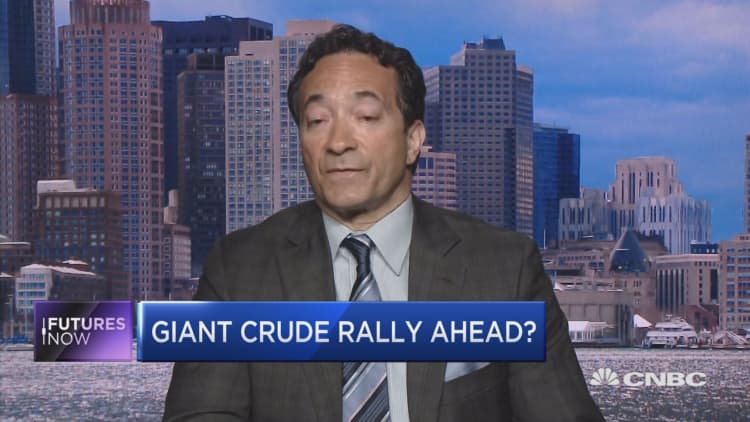Bloated global crude oil inventories are declining but not as quickly as OPEC expected, adding to pressure on the producer group to extend supply cuts, according to a CNBC poll of energy strategists, traders and economists.
Oil markets are questioning whether OPEC's current phase of production cuts totaling 1.2 million barrels a day–agreed in November, effective from January and the first since 2008–are enough to re-balance the market when U.S. producers are aggressively increasing supply and U.S. inventories remain stubbornly above five-year highs.
Producers outside the Organization of Petroleum Exporting Countries including Russia pledged to cut around 600,000 barrels a day.
"OPEC producers have under-estimated the volumes to be taken off the market," said Victor Shum, vice president at IHS Energy.
"The drawdown in the U.S. inventories is not going to be fast and furious. Ultimately, the objective is to support prices. Gulf producers need money to balance the budget. That's a strong incentive to cut more than they have."

The findings of CNBC's second-quarter poll of 28 analysts reflects continued concern over the supply picture and OPEC's efforts to re-balance the market. Brent crude will likely average $54.55 a barrel in the April to June period, little changed from the first-quarter average of $54.57 a barrel.
Price forecasts for the second-quarter ranged from as low as $45 to as high as $63 a barrel. The most bearish forecasters warned prices may drop to the mid-forties or below if OPEC and its outside producer allies fail to agree to extend production at May 25 meeting in Vienna.
Though compliance to the latest production deal has been strong, at 90 percent according to a survey by Reuters this week, with de facto OPEC leader Saudi Arabia doing most of the heavy lifting, it hasn't been enough to dislodge the global oil glut.
That's put the ball back in OPEC's court.
"There is an obvious compelling fundamental reason to extend cuts given the inventory objective–these are simply not declining fast enough (as acknowledged by Saudi Arabia and other producers) even if we were to account for seasonal factors that limit crude oil demand like refinery maintenance," said Harry Tchilinguirian, global head of commodity markets strategy at BNP Paribas, who expects Brent crude to average $57 a barrel this quarter.
Turning back that tide of supply isn't "realistically feasible" in six months, Tchilinguirian said, citing year-on-year production growth in U.S. shale oil, an "unrelenting" increase in active oil rigs and supply growth in Canada and Brazil. "Right now, it is all about supply and not demand."
Even a simple six-month rollover of the first round of OPEC cuts may not be enough to satisfy oil market bulls.
"Despite a possible extension of the OPEC agreement… prices are likely to continue their slide in Q2 and I see higher chances of them dropping below $45 than rising above $55," said Eugen Weinberg, head of commodities research at Commerzbank.

The closely-watched U.S. rig count–which comprises U.S. onshore and U.S. offshore Gulf of Mexico drilling rigs - hit 971 in April, up 107 percent from last year, according to Platts RigData. U.S. production is at its highest since August 2015.
"U.S. rig rates have now increased to levels that will allow production growth," said James Davis, upstream analyst at consultancy FGE.
"We see it inevitable that OPEC will have to extend its cuts a further 6 months if not longer. Latest stocks data indicates that there is unlikely to be a significant stock draw through the first half of 2017, which is one of the main indicators that OPEC will be looking at when they meet next to decide what action to take."
Commercial U.S. crude inventories in the week to April 28 fell by 0.9 million barrels, marking the fourth week of declines. Stockpiles still stand at a near-record 527.8 million barrels and well above the five-year range.
"It seems the frackers have more influence on pricing at this point than OPEC does," said CNBC contributor Anthony Grisanti, founder and president of GRZ Energy.
However, Grisanti and survey respondents with a more constructive view on oil suggested U.S. production may be closing in on a near-term peak.
"While fracking has come back I don't see production from them increasing much more from these levels–banks won't finance those operations like they used to–and as the price falls some of those new wells become unprofitable once more."
Grisanti expects oil to average between $50 to $55 this summer.
Christopher Haines, head of Oil & Gas, BMI Research, also predicted U.S. output may start levelling off.
"US production will grow, though likely not as strongly as many people are expecting. While drilling has been strong, we have yet to see the same level of activity in completing wells, which will limit the aggressiveness of growth."
Consultancy Energy Aspects–the most bullish forecaster in the CNBC survey–said the markets were too fixated on U.S. stockpiles and needed to consider inventories on a global basis.
"We expect fundamentals to improve over Q2, but the path to rebalancing may not be fully clear for the market without some data cleansing," said Miswin Mahesh, chief oil analyst at Energy Aspects, who expects Brent prices to average $63 this quarter.
"Overall for Q2, our balances show a stock-draw of 1.2 million barrels a day. We expect North American supplies to grow 600,000 barrels a day year-on-year in Q2, but this is offset by fall in supplies elsewhere in non-OPEC."



